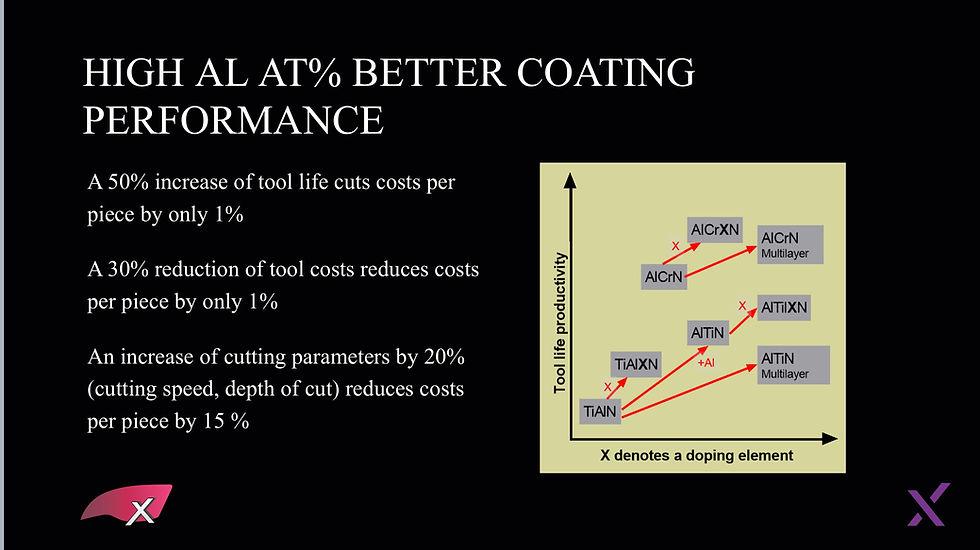AlCrN coatings and the importance of high Aluminum content
- Christos Pernagidis
- Mar 14
- 3 min read
Updated: Jun 6
Market outlook: The growing demand for high-performance coatings
The global market for wear-resistant coatings is projected to reach over $14 billion by 2030, with PVD coatings alone expected to grow at a CAGR of 6-8% over the next decade. Among these, Aluminium Chromium Nitride (AlCrN) coatings are gaining increasing attention due to their exceptional properties.
With industries continuously pushing for higher machining speeds, longer tool life, and better thermal resistance, demand for advanced coating materials is on the rise. AlCrN coatings, particularly those with a high aluminum content, are at the forefront of these developments, offering superior oxidation resistance, mechanical strength, and tribological performance. However, the challenge remains: how to optimize AlCrN coatings to unlock their full potential.

Why AlCrN coatings are essential
AlCrN coatings are known for their outstanding oxidation resistance, thermal stability up to 1100°C, high hardness (30-35 GPa), low friction, and chemical inertness. These characteristics make them ideal for applications involving extreme thermal and mechanical stress, such as high-speed machining of hardened steels, aerospace components, and high-performance cutting tools.
Increasing the aluminum content in AlCrN coatings can further improve thermal stability, hardness, and wear resistance. This is due to the formation of a protective Al₂O₃ (aluminum oxide) layer, which enhances oxidation resistance and protects the underlying material at high temperatures. However, conventional deposition methods face a major limitation: when aluminum content exceeds 60-70%, the coating structure may shift from the preferred cubic (fcc) phase to a less beneficial hexagonal (hcp) phase, reducing mechanical properties.
Overcoming limitations with HiPIMS technology
To achieve high-aluminum AlCrN coatings without compromising performance, the deposition method is critical. This is where High Power Impulse Magnetron Sputtering (HiPIMS) plays a transformative role.
HiPIMS deposition offers:
✔ High ionization rates (up to 90%) for superior coating density
✔ Better energy control to maintain the cubic phase structure
✔ Significantly improved adhesion compared to conventional sputtering methods
✔ Reduced defects and enhanced hardness


By leveraging pulsed plasma technology, HiPIMS enables the preservation of the cubic phase even when the aluminum content exceeds 70%, a significant breakthrough in the field. This ensures coatings remain wear-resistant, thermally stable, and mechanically robust, making them suitable for cutting-edge industrial applications.
The real challenge: Increasing Aluminum content without sacrificing performance
While adding aluminum to the face-centered cubic (fcc) CrN structure enhances hardness through solid solution hardening, there is a limit. Research shows that the metastable fcc-AlCrN phase remains stable at an Al/(Al + Cr) ratio between 0.67 and 0.80. Beyond this threshold, the coating risks transitioning into a metastable hexagonal close-packed (hcp) phase, which negatively impacts hardness, wear resistance, and tribological performance at high temperatures.
This raises a crucial question:
How can we effectively increase aluminum content in AlCrN coatings while maintaining superior mechanical properties?
Industry secrets: What many companies won’t tell you
Despite the hype around high-performance AlCrN coatings, many manufacturers remain vague about the actual aluminum content in their coatings. If the aluminum percentage is below 65%, the coating is far from exceptional—yet this information is rarely disclosed.
For years, coating manufacturers have focused on conventional strategies such as:
✔ Microstructure control
✔ Duty cycle optimization
✔ Bias voltage adjustments
✔ Varying nitrogen or aluminum content
While these methods have contributed to some improvements, true breakthroughs have remained elusive. It wasn’t until a fundamental shift in research and development—driven by pioneering HiPIMS technology—that the industry began to see significant advancements in high-aluminum-content AlCrN coatings.
Want to learn more? Let’s talk!
If you are looking for cutting-edge insights into high-performance AlCrN coatings, don’t hesitate to reach out.AlCrN coatings and the importance of high Aluminum content



Comments